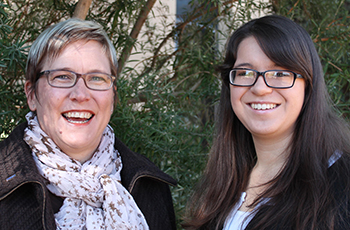Centre for Universal Access and Disability Support HOD selected as prestigious Fulbright scholar

Hetsie Veitch and Gabriela Schroder
Photo: Valentino Ndaba |
Hetsie Veitch, who has served as the Head of the Centre for Universal Access and Disability Support at the university for the past seven years, recently won the prestigious Fulbright Scholarship for studies in the USA. Hetsie has been placed at the renowned Syracuse University in Upstate New York, where she will read for a PhD in Disability Studies in the School of Education.
By focusing on matters of social justice in the pedagogy of higher education, Hetsie will explore the creation of universally accessible learning spaces for students so that she can apply these ideas on her return to South Africa in four years.
Under her leadership, the Unit for Students with Disabilities (USD) was transformed into the Centre for Universal Access and Disability Support (CUADS) in order to reflect new approaches to universal access and universal design.“It is my ultimate goal,” says Hetsie, “to create an institutional culture that includes and welcomes all students with disabilities.”
It is difficult to fully capture the enormous contribution Hetsie has made to the UFS in disability justice, by establishing platforms for students with disabilities that enable them to be appreciated as individuals, and to excel in academic studies.
One of our star students, Gabriela Schröder, also won the prestigious Fulbright Scholarship. Gaby, as she’s called, will be taking up doctoral studies in Biochemistry at a leading university in her field, namely North Carolina State University in Raleigh, North Carolina.
Gaby earned her BSc Honours degree in Biochemistry at the University of the Free State, after also completing her undergraduate studies in Chemistry and Biochemistry at Kovsies.
She participated in the F1 Leadership for Change Programme (Class of 2011) as part of the first-year cohort that went to the University of Vermont. In 2012, she was selected to participate in the elite Stanford Sophomore College Programme with students from Oxford University (UK) and Stanford University in California.
In 2014, Gaby was awarded the Dean's Medal, a distinction which is presented to the best final-year student studying towards a Bachelor’s degree in the Faculty of Natural and Agricultural Sciences. She was also the proud recipient of the Senate Medal, awarded for academic excellence in the achievement of a Bachelor’s degree at the university.